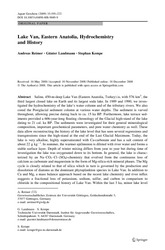Lake Van, Eastern Anatolia, Hydrochemistry and History
Reimer, Andreas
Landmann, Guenter
Kempe, Stephan
15, 1: 195 - 222
DOI: https://doi.org/10.1007/s10498-008-9049-9
Persistent URL: http://resolver.sub.uni-goettingen.de/purl?gldocs-11858/7091
Persistent URL: http://resolver.sub.uni-goettingen.de/purl?gldocs-11858/7091
Reimer, Andreas; Landmann, Guenter; Kempe, Stephan, 2008: Lake Van, Eastern Anatolia, Hydrochemistry and History. In: Reimer, Andreas; Landmann, Günter; Kempe, Stephan (2008): Lake Van, Eastern Anatolia, Hydrochemistry and History - Aquatic Geochemistry; Vol. 15, Nr. 1, p. 195-222. Springer Netherlands, DOI: 10.1007/s10498-008-9049-9.
 |
Dokument öffnen: |
Saline, 450-m-deep Lake Van (Eastern Anatolia, Turkey) is, with 576 km3, the third largest closed lake on Earth and its largest soda lake. In 1989 and 1990, we investigated the hydrochemistry of the lake’s water column and of the tributary rivers. We also cored the Postglacial sediment column at various water depths. The sediment is varved throughout, allowing precise dating back to ca. 15 ka BP. Furthermore, lake terrace sediments provided a 606-year-long floating chronology of the Glacial high-stand of the lake dating to 21 cal. ka BP. The sediments were investigated for their general mineralogical composition, important geochemical parameters, and pore water chemistry as well. These data allow reconstructing the history of the lake level that has seen several regressions and transgressions since the high-stand at the end of the Last Glacial Maximum. Today, the lake is very alkaline, highly supersaturated with Ca-carbonate and has a salt content of about 22 g kg−1. In summer, the warmer epilimnion is diluted with river water and forms a stable surface layer. Depth of winter mixing differs from year to year but during time of investigation the lake was oxygenated down to its bottom. In general, the lake is characterized by an Na–CO3–Cl–(SO4)-chemistry that evolved from the continuous loss of calcium as carbonate and magnesium in the form of Mg-silica-rich mineral phases. The Mg cycle is closely related to that of silica which in turn is governed by the production and dissolution of diatoms as the dominant phytoplankton species in Lake Van. In addition to Ca and Mg, a mass balance approach based on the recent lake chemistry and river influx suggests a fractional loss of potassium, sodium, sulfur, and carbon in comparison to chloride in the compositional history of Lake Van. Within the last 3 ka, minor lake level changes seem to control the frequency of deep water renewal, the depth of stratification, and the redox state of the hypolimnion. Former major regressions are marked by Mg-carbonate occurrences in the otherwise Ca-carbonate dominated sediment record. Pore water data suggest that, subsequent to the major regression culminating at 10.7 ka BP, a brine layer formed in the deep basin that existed for about 7 ka. Final overturn of the lake, triggered by the last major regression starting at about 3.5 ka BP, may partly account for the relative depletion in sulfur and carbon due to rapid loss of accumulated gases. An even stronger desiccation phase is proposed for the time span between about 20 and 15 ka BP following the LGM, during which major salts could have been lost by precipitation of Na-carbonates and Na-sulfates.
Statistik:
ZugriffsstatistikSammlung:
- Geologie [933]

